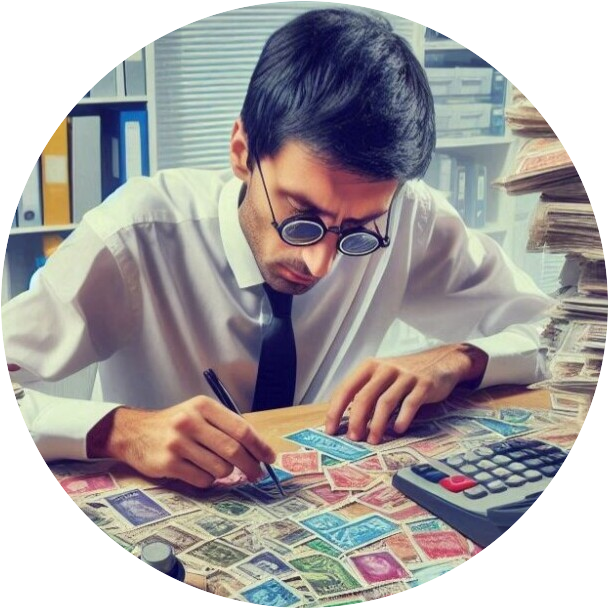
High value stamps are like tiny passports through history, each with a story waiting to be uncovered. But what makes a stamp hit the jackpot in the collector’s market? It all comes down to rarity, historical significance, and condition. Think of stamps as historical artifacts – each one a snapshot of a specific moment, its worth defined by the journey it’s been through.
Ever wondered why some stamps fetch astronomical amounts at auctions? The backstory plays a huge role. Stamps tied to significant historical events or figures, or those marking pivotal postal history moments, have an edge in the value department. It’s these connections to history that often make collectors’ hearts race and auction paddles fly.
Rarity is another big-ticket item on the value checklist. Stamps that were printed in limited numbers or those that managed to survive the odds against all sorts of damage are like gold dust to collectors. The fewer there are, the more they’ll command the spotlight and, of course, command higher prices.
Condition can make or break a stamp’s value in a big way. Collectors love stamps that look brand new, free from creases or stains, with bright colors and sharp perforations. It’s like the mint condition craze in baseball cards or classic cars – the better preserved, the heftier the price tag.
This labyrinth of rarity, history, and condition makes stamp collecting not just a hobby, but a real-life treasure hunt, each stamp a potential gem waiting to be discovered.
Famous High Value Stamps and Their Stories
Peeking into the lives of some of the most celebrated high value stamps is like flipping through history’s scrapbook. Take the Inverted Jenny, for example, a mishap that turned into one of the most sought-after stamps in U.S. history. This 1918 airmail stamp became legendary due to an upside-down airplane error, and these accidental masterpieces have turned into golden tickets at auctions.
Then, there’s the British Guiana 1c Magenta. It’s dirty, not what you’d call eye-catching, yet it holds the title of the world’s most expensive stamp. This one-of-a-kind survivor from 1856 hails from a small print run, and its journey through hands as varied as schoolboys to billionaire collectors just adds to its mystique.
Don’t forget the duo from Mauritius, the Blue and Red stamps, which were among the British Empire’s first colonial issues. Stamped with a ‘Post Office’ inscription instead of ‘Post Paid’, a handful of errors made these pieces among the most coveted. Each bears tales of their island origin, adding layers to their charm and desirability.
These stamps don’t just carry mail, but stories marked by misprints, limited runs, or simple survival against the odds. For collectors and history buffs, they’re absolute gold mines, offering a tangible connection to the past and glimpses into bygone eras.
Identifying and Evaluating High Value Stamps: Expertise Matters
Getting your hands on high value stamps takes more than just luck. It’s all about knowing what to look for, and that includes understanding the finer details like provenance and authentication. A stamp’s provenance – its ownership history – provides a paper trail that can significantly ramp up its value. Authenticity stamps out forgery concerns, which can plague the world of high-value collectibles.
Using the right tools and resources is like having a specialized toolkit to uncover these miniature treasures. The magnifying glass is just the start; catalogs and online databases offer a wealth of information on stamp characteristics and their backstories. Not forgetting expert opinions, which are gold when you’re trying to verify the authenticity or value of a potential find.
Connecting with the pros will also give you a leg up. Reaching out to stamp experts or philatelic societies can provide guidance and validation that’s worth its weight in…well, rare stamps! These networks can steer you clear of counterfeits and guide you to stamps that are more likely to appreciate in value.
With the right mix of knowledge, resources, and connections, navigating the stamp scene becomes less about chance and more about skill. And remember, practice makes perfect – the more you immerse yourself in this world, the better your eye becomes at spotting potential gems in even the unlikeliest places.
Investing in High Value Stamps: Risks and Opportunities
Investing in high value stamps is a mix of passion and strategy. For some, it’s a hobby that might just turn profitable. To eye whether a stamp’s value is likely to soar or remain grounded, you gotta keep tabs on market trends and demand. You know, much like classic cars or vintage wines, the collectible market can be pretty unpredictable.
Understanding the long and short of it is key. While some folks hold on to their stamp collections like precious heirlooms, gradually increasing their investment potential over decades, others are in for the quick flip. Deciding which path to follow can be crucial to your strategy – do you have the patience of a saint, or are you more of a thrill-seeker?
If you’re looking to buy or sell without losing your shirt, it’s all about building relationships. Auctions are great places to get a feel for what’s hot and what’s not, but rubbing elbows with fellow collectors might lead you to hidden treasures off the beaten track. Online platforms can also offer insights – just be sure to vet sellers like you’re Sherlock Holmes.
A heads-up: with high reward comes high risk. Prices can fluctuate, and sometimes that prized stamp might not quite reach the heights you hoped for. Stay informed, be discerning, and most importantly, let your decisions be guided by both your heart and your head. After all, each stamp is a little piece of history, and that’s something worth investing in.
